Investigation Events
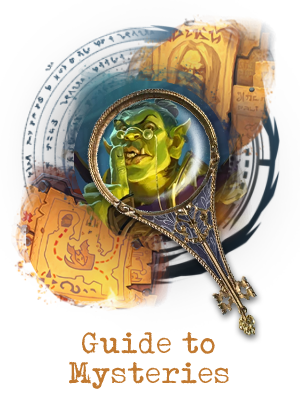
A guard stumbles across a criminal situation and needs to find the culprit. A spy uses a cover as a courier to receive and deliver vital messages for an employer or organization, intending to learn who is trading info, what secrets are trafficked. A farmer loses their flock of sheep seeing the muddy torn ground of wolves in chase of prey. A lady finds a party guest dead with a nasty lump on their head and a dagger protruding from their back in the mansion’s library.
The opportunities of investigations are vast and can make up a single scene for an event or build upon as the cornerstone of an entire event or campaign. They may spring up just from the interest of your attendees/players wanting to learn more about a situation, requiring you to come up with details on the fly. Or they may be the entry into a war situation or entering enemy territory for battles to rage in the next hour.
This guide provides information on how to build an investigation, key questions to answer before an event, and how to determine DC and results to quickly keep your event moving with dramatic and gritty detail.
This guide can be used for MMO-RPG in-game events, tabletop games, LARPs, and more! Examples include tabletop and MMO images. The rolling rules are for a d20 system, but you could easily convert this to a d10 World of Darkness table of successes and botches, d6 Shadowrun system, and so on.
What makes a good investigation?
Before we dive into how to create an investigation, let’s touch on what makes a good scene.
Depending on your event type, RP or d20 with rolls, you don’t want an investigation to simply be: you find a dead body, roll/investigate sequence, it died by stabbing, and then throw information to hurry them along to what you care about more for an event. Events are journeys, and while you may adore combat or want them to rush to the end boss due to the cool mechanics you built, these situations can add flavor, depth, intrigue, perhaps even lovely foreshadowing to what will come.
These events do not need to be CSI: Warcraft or NCIS Waterdeep. Of course, you can go that route, and can be rich and fulfilling. But touching on those ideas and actions can deepen the story around your finale scene and give your diverse cast of players something meaningful to do.
What are the building blocks of incredible investigative storytelling? Let's get started!
Investigation Building Blocks
The following are just a few building blocks of story and mechanics to consider when creating investigations.
Consider starting from the end and working backwards. To help plan your investigation, begin with the end and work backward. If a murder or theft, start with the culprit, method, item, etc. Work back to where and how it occurred, how it was committed, to plot out the path of clues and evidence.
Set the motivation, intent, and goal of the crime/scene/situation being investigated. Knowing these key pieces is helpful, and gives you a specific set of goalposts on the journey. Players can start out right then veer off into weird tangents and angles getting lost. With these goals in mind, you can lead them back and keep them moving forward. Examples to come as we build an investigation.
It’s all about the details. Every piece of evidence can have a backstory like any character. Think about what the evidence looks like, how the scene is laid out, signs of movement around the area (could indicate multiple people there), signs of struggle, signs of a cleaned up space, something out of order, something missing (dust rings), something added. Details give you so many pieces of information you can provide based on areas players search, multiple rolls from failures to critical successes. Write up tons of details. You can copy and paste these for all to see, in whispers to players, as hints of places or things to investigate.
The party finds a body with a blade stabbed in the back. How do we add details?
- Crest from a rival house in hilt
- Sheen of poison upon the blade (they could try to learn what poison)
- Gleam of magical power if a magi attempts to grasp it or urge someone to grab it (like a curse)
- Clean blade despite being stabbed deeply indicating it was placed after death
- Broken blade unable to kill the victim
- Belongs to someone in the event party (discuss earlier with them)
For the area, maybe there are toppled furniture indicating a struggle. Perhaps drawers to a desk are ripped open, papers everywhere, contents tossed indicating a search or theft in progress…but who searched? That could lead to intrigue and additional searches.
Provide multiple clues and paths to solve the mystery. Players may not find all of your clues or determine what to do with them. Placing clues in their path, reinforcing the direct, can help if they miss steps. Allow them to go back and check the scene if they realize they missed something or need to verify anything.
Determine multiple outcomes. Sometimes the best investigations are not 1 + 1 = 2. Stabbing + Theft = Thief did it. Just like the movie Clue, having multiple possible endings give you a chance to shift the tale, highlight key details that match the event’s scenes. And sometimes, Players have better ideas! Their leaps in logic might give you new ideas. Don’t be afraid to use them, leverage the paths their thoughts take. Sometimes those small changes can give players investment, that they figured it out or were right. It’s a great feeling for you and the group.
Also having multiple outcomes gives you the power of continuity! What if they only figured out 3 of 5 important pieces of the puzzle and the event comes to a close. This can lead to foreshadowing and further investigations in the next event or come up much later in other stories you craft. It may also lead to further role play as some players want to find those endings, drawing them into your webs of plot and tension.
Consider the skills and mechanics of finding and judging details. Story and role play are incredible to a scene and event, but mechanics can destroy the hard work you put in. Take the time to write out your DC or role play checks for finding details. Write out responses or results for those DCs. Also consider giving something special for critical fails and successes.
You can find a ton of incredible sources for inspiration. Here are just a few:
- TV: Crime for normal world and sci fi fantasy, some favorites Murder She Wrote, NCIS, Law and Order, CSI, Bosch, The Dresden Files, The Lost Room, Sherlock, Morse, any BBC detective series, Columbo, Peter WHimsey, ID network shows, sci fi fantasy list
- Movies: The Usual Suspects, Knives Out, North by Northwest, Bad Times at the El Royale, Clue, The Name of the Rose, all Agatha Christie, Primal Fear, Harry Potter, Detective Dee, Indiana Jones, Chinatown, Robert Langdon movies, National Treasure, Asian mysteries, Korean myserties
- Books: Agatha Christie, Sherlock Holmes, Nancy Drew, PD James, Dorothy L Sayers, Parker Bilal, John Grisham, James Patterson,too many to count
- Other ideas: Escape rooms, Hunt a Killer box, true crime documentaries
Building an Investigation
The following exercise will guide you through creating investigations for your events and campaigns. As we go, we will create two types of investigations as examples: dead body in a library (yay Clue references) and scouting party in the woods.
See How to Run Events & Campaigns for information and the following tips for investigations:
- Give your investigation a theme. This can help you form ideas, find locations, pull from existing sources, and hone in player expectations. For example: theft at the magic school, murder at the party, spy vs spy, thieves guild challenge, town invasion, rival groups arriving at the same ruins, the cursed blade, theft at the wedding, kidnapping of the mayor's son, the lost squad, and so on.
- Create lists of items and clues players can find throughout the investigation. Mark multiple places and NPCs holding the information.
- Pay attention to player ideas. They may leap to conclusions that are better or interesting. Keep note of their ideas to slip into other aspects of your events. This gives players a sense of being on the right track.
- If players come to incorrect conclusions, let them go down the wrong track so far. If they need to be lead back to the plot, offer rolls or spark conversion, give whispers or info directly to some players, let them find their path.
- Create a map to track your investigation. Here is an example for MMO Warcraft events.
Set the Investigation
Determine what the investigation is. This could be a couple sentences, which gives you something fantastic to give players when starting the event. Optional details could be title, NPCs, etc. Just don’t overwhelm yourself with details yet.
- What happened to Lord Ferris? Potential investigations his murder or kidnapping. This investigation will occur in one room. For this guide, going with murder in a house.
- Tracking around camp. Potential investigation enemies set up traps and spying or camped near ruins filled with ghosts. This investigation will move from one location to the next. For this guide, going with enemies spying on a camp.
Set Key Factors
When you have a scene coming up that may incur investigations, give yourself key information to fall back on.
- What can they investigate? Give them key areas and directions or you will be there for hours sifting through meaningless details.
- What clues lead from this item/situation? Consider minor to major, directly connected to the object of investigation/the culprits or loosely affiliated to the actual scene.
- Who or what is connected to the item/situation? What are the motivations?
| Dead Lord Ferris | Forest Trail at Camp | |
|---|---|---|
| What can they investigate? |
|
|
| Clues from the area? |
|
|
| Connection & motivation? |
|
|
Set a Difficulty Class
This is the difficult (DC) required on a roll or roleplay to complete a task or get info. You can set a DC for both quite easily and effectively, just to give context of finding or missing things. Consider awarding not only successes but failures, these could be painful finds, breaking evidence by finding it, or discovering incorrect details to increase tension or misdirect.
DC for Roleplay Events
For roleplayed freeform difficulties, you do not judge a roll result but keep a keen watch on position, path, described focus, and actions. For investigations, use the set locations to have players divide up and search.
Read through their text and provide information based on their attention to detail:
- Set areas they can search (icons used as examples).
- Watch their roleplay actions and details.
- Provide insights only based on their details, giving them more to check or considerations to make.
- Consider their class, backstory, present interests when deciding what they find. Someone distraught may miss details, overzealous players may find a ton of details (some real, some false), a magic user may focus on arcane clues while a warrior checks the killing blow.
- Don’t feel obligated to give all the details simply because they said they searched where you indicated. Have them work for it, interact, and come to conclusions. Provide incentive through the environment, a sense they believe they are correct, and outside force or NPC agreeing.
- If they fail to find the correct clues, don't force the information or punish them for missing it. Provide hooks into the next areas and scenes that point back to it or have it be a detriment later. Sometimes a failure is just as telling, and can muddy up a scene adding depth.
Example for a roleplay investigation of the Forest Trail:
Trees | Trees and bushes have been dug up and moved from here, leaving open holes in the earth and newly planted seedlings. It aids in moving cover for spying scouts to wait. Some trees have been pulled over, branches tied, to form a hiding place for spies to lie in wait. Marks from animals are old, having left this area some time ago. But fresh claw marks mark higher branches, from owls the spies of the elves. |
Mounds/Bodies | The mounds of earth and undergrowth hold a sense of druidic magic. It seethes with a glow that reaches to branches and vines. You have faced warfare in these woods before, and the shadows of the trees hold a threat, perfect place for an ambush... As you near, a trap of entangling roots and vines awaits to unleash! |
Trail | A sickly sweet scent of death and blossoms rises from the underbrush, definitely from a larger body not some small animals. Flies buzz, a sign of fresh death, while the scent of decay seems older. Brushing back leaves, you spy two bodies wrapped in entangling roots. Both hold the marks of allies. The bodies have died from one of many methods. Strangled by vines. Sucked dry by roots. Poisoned by flowers. They are not slashed, stabbed, or pierced by weapons. |
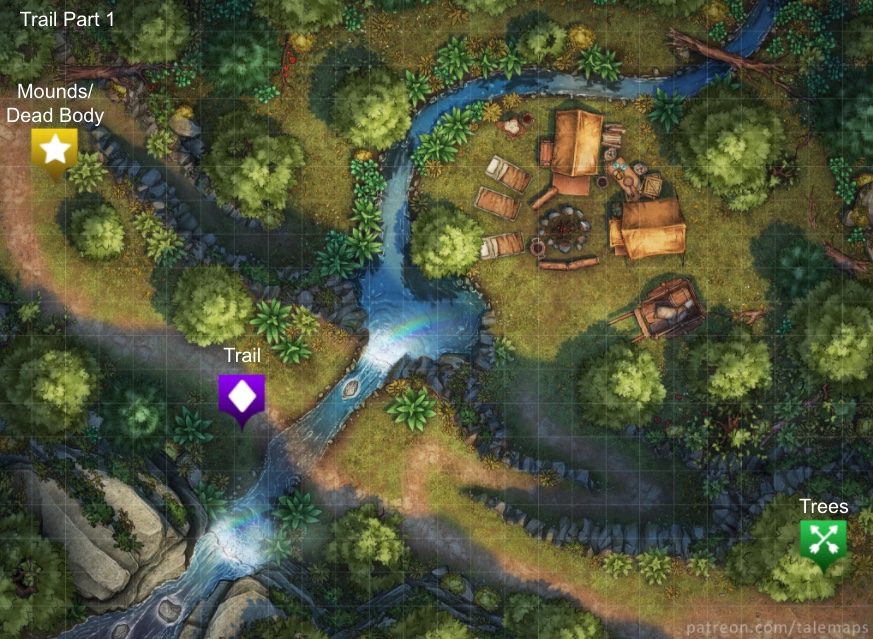
Map by Talemaps!
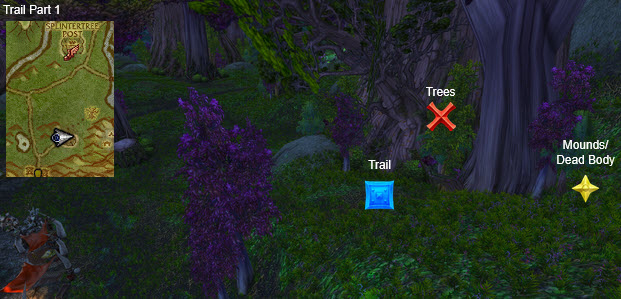
Ashenvale Horde Camp near Barrens border, World of Warcraft
DC for Rolling Events
These games you roll to get a result. Usually 1-20 or d20 die with 1 being a critical failure and 20 a critical success. If you use custom game rules for MMOs or tabletop systems, bonuses may be added on rolls to go beyond a 20 or to reroll. Also what they roll differs for these situations.
- Tabletop System: As noted previously, this could be any system using dice. Convert table results as needed, roll DC vs number of successes, etc. This uses a d20 system.
- Homebrew: Use special rolls set by group, guild, or your own
- Champion’s Compendium: Traits rolls, items can influence results
- Warcraft Conquest Simplified 1.2: Perception or Expertise rolls, Perceptive +5
For all of these systems, you have control to set the DC and what players learn. Here are recommendations with examples from the Death of Lord Ferris:
| Roll | Results | Example |
|---|---|---|
| 1 | Critical Failure. Consider finding and destroying evidence, misdirecting unrelated evidence, or a curve ball. | You take care looking over the body, considering the scene. As you step back, you trip over a chair, spin away from the desk, and fall into a wall...that opens to a hidden tunnel! |
| 2-9 | Failure. They may not find incredible details, but you can give them additional information based on what they check. | The dagger is stabbed through the back, between the shoulder blades. Definitely a killing blow. |
| 10-14 | Success. Provide additional details that could lead to further investigations. | The dagger has a house symbol you know is a rival of the victim. You know some members of that rival house are visiting the party. If one of them is missing a blade...? |
| 15-19 | Great Success. Provide detailed information regarding the investigation, strong evidence that could lead to | The wound should have far more blood than it does. The rug is doused in wine, not blood. You don't see any cups or goblets, but there is a bottle half empty. |
| 20+ | Critical Success. Provide finer points that are rare and difficult to find. | The wine soaked rug has a slight scent of poison, some of th frayed threads are burned from the acrid contents. It's potent! |
Set the Scene
I strongly recommend prewriting a few things that may be lengthy. This cuts down on waiting for responses and keeps the event moving forward. Here are examples:
- Description of the scene: What they see, what’s available to investigate, consider all of the senses (sight, smell, hearing, touch, taste).
- What can be investigated: One line with a raid marker in text detailing what is there to check.
- DC responses: Set up your DC and results, keep these short, you can expand on them as you like while in game to make it special.
- Questioning staff: What if they want to question a servant? If you would like active interaction, add a servant and give them some lines to provide.
Connect your content with the physical location. Add raid markers per area they can investigate. This helps you track what players are checking, connecting to your DC rolls and descriptions. To make your life easier, take screenshots and create images plotting your raid markers. If you don’t have a chance to set them with another player, use screenshots and Google Drawing. Here is an example:
Bookcases | Books tumble from the shelves, spilling across the floor, tossed back and forth from their places. Loose parchment juts from books, between stacks, yanked free from bindings. Someone hunted madly for a page, something tucked in a book or hidden behind the stacks. |
Body | Lord Ferris lies dead, one arm outstretched with the other curled underneath. His robes tightly wind around his body, legs caught yet in jagged angles as if running when stabbed or...something else. His eyes stare wide, bulging from the sockets, lips parched, jaw clenched tight. Blood and wine stains his jaw. A dagger portrudes from his back. |
Rug/Wine | A thick rug of hand-woven soft yarn shifts in shades of scarlet, gold, and emerald with lines of onyx depicting a house seal, floating above arches, grand designs. Wine soaks through the artwork, spreading forth as if seeking to cover the house symbol. The body covers most of the designwork. An empty scrollcase has rolled from the body to rest in the wine stain. |
Desk | A fine desk of rosewood and inlaid ivory is a mess of shuffled papers, spilled inks, ripped open letters and mail. Drawers have been pulled open, contents searched. One remains locked despite the marred marked of someone trying to force it open. |
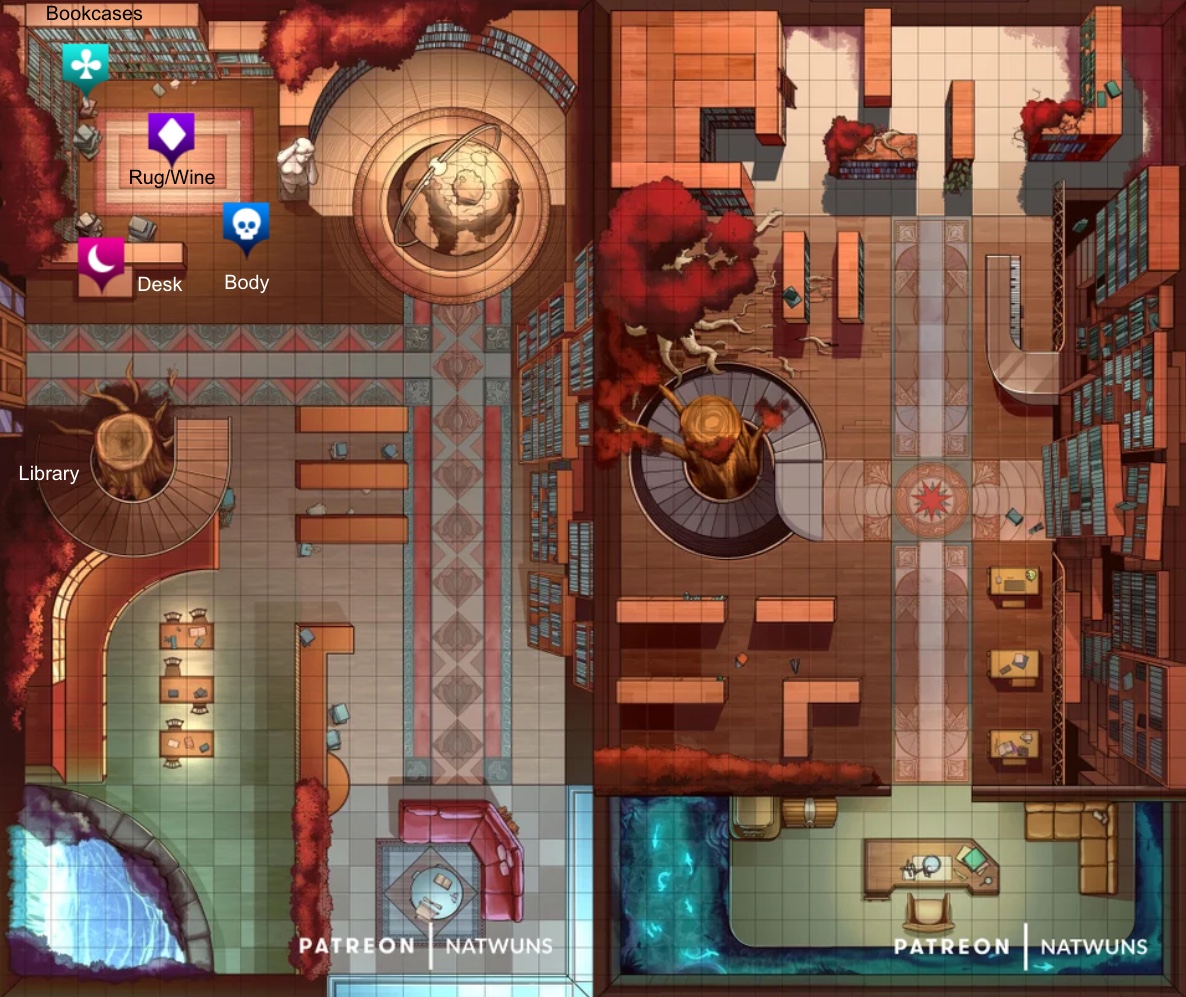
Map by Natwuns!
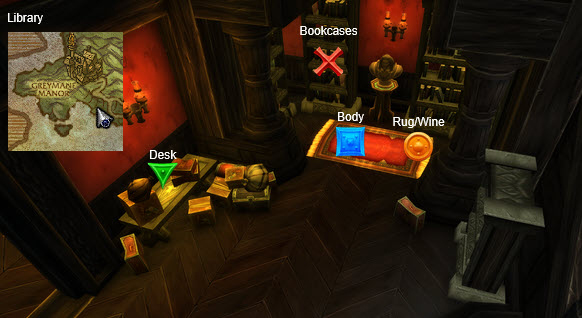
Gilneas Greymane Manor, World of Warcraft
Run the Event
Much like a battle, these events will have a beginning and finale. Investigations may have multiple scenes and locations, one leading to the next. You can follow these examples for each transition, giving players more to investigate and connect until they reach the final encounter.
Connect environmental rolls and situations to solve. You can definitely mix battle and environmental obstacles in your investigation, the same as you can add investigation scenes into a battle event.
- For the library, they may have someone become sick from the wine if taste-tested, magic wards could flare, the dagger could be cursed if pulled from the body.
- For the trail, the entangling roots trap could be triggered, attempting to catch one or more players to strangle and poison, a sapling could suddenly grow and attack as a forest protector.
Connect your clues when moving scenes. Players will use the clues to build their case and seek answers. Give them NPCs with information if asked. Consider giving studied results by magic, alchemy, battle knowledge, history, and other knowledges and skills.
- For the library, the dagger may have been taken from a rival noble without their knowing, a goblet with the same poison found at the dinner table with a different color, a scroll of special paper radiating magic in a servant's pocket.
- For the trail, a sample of cut root leads down a path of matching druidic magics and marks, a rush of footprints of large cats rush through the forest just ahead matching those found at the trail, new sapplings pop out to fight just like those at the trail.
Consider failures and misdirection clues to false accusations but new solutions. Perhaps some of the clues learned and investigated that were incurred due to a critical failure cause incorrect assumptions. This can add depth or force the hand of the real culprit, turning a negative into a positive.
- For the library, the rival noble had nothing to do with the death and could provide insights on the poison, the hidden passage leads to a servant's room and another dead body...maybe the servant you see if polymorphed!
- For the trail, the large cat's prints are not an enemy but potential ally, as you see a tauren druid battling for their life in entangling roots, having only moment's to live!
You have created a great investigation. Have fun, tweak as you need, build your events one to the next for a grand campaign. You can use investigations in battles, stealth missions, scouting parties, and so much more!